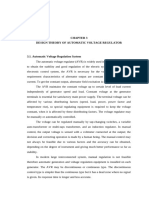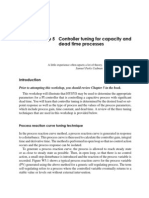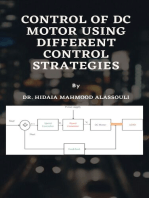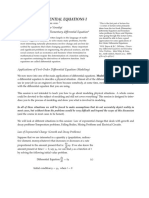Loop Optimization: Troubleshooting
Uploaded by
samandondonLoop Optimization: Troubleshooting
Uploaded by
samandondonReprinted with permission from CONTROL Magazine, April 1999
Loop optimization: Troubleshooting
Diagnose loop behavior to find and correct problems with final control elements, the
environment and upstream systems before you tune the controller.
Michel Ruel, P.E. TOP Control Inc
Plant efficiency and consistent product quality depend on proper loop performance, but PID tuning is only
the last step. This is the second in a three-part series on loop optimization. In March, Part I discussed defining
your objectives and understanding the limitations of equipment.
Before tuning a PID controller, it’s wise to perform a series of tests on the loop to find any conditions
that would compromise its performance, and correct those conditions if possible to make the tuning
more effective.
Last month we mentioned the questions that should be answered before PID tuning:
1. Process gain: Is the control valve sized properly?
2. Are hysteresis or stiction excessive?
3. Is the dead time short enough?
4. Is there an excessive amount of noise in the loop?
5. How nonlinear is the loop?
6. Asymmetry: Does the loop respond differently in one direction than in the other?
7. Is the loop optimally tuned?
These questions can be answered through a series of tests.
The tests
Testing is performed by collecting data with the controller in automatic mode under normal operating con-
ditions, then introducing a step change. For further diagnosis, data can be collected with the loop in manual
mode for comparison.
When collecting data, the scan time must be smaller than or equal to the update time in the controller, and
the update time should be smaller than the equivalent dead time of the loop. In many controllers, the update
time is user-selectable.
Collected data will show the operating range and performance of the final control element. Is the controller
output operating at one end of the range? Is the valve operating near its seat? Does the controller output
change by a very small amount? If so,the valve or final control element may need to be resized to give better
controller output resolution.
Does the loop cycle? If the loop cycles in automatic but not in manual mode, the cause of the cycle is the
closed loop. The cycling may be due to hysteresis, nonlinearities, or poor tuning.
A cycle in a linear loop caused by poor tuning will look sinusoidal. A sawtooth-shaped cycle can be caused by
stiction or by nonlinearity.
Cycling due to hysteresis usually has a longer period when theprocess variable is near the setpoint. As the
error is reduced, the controller output change is gradually reduced and the effect of hysteresis becomes
more important.
Metso 20965 Crossroads Circle Waukesha, WI 53186 USA
+1 262 369 7711 Expertune.Sales@mesto.com www.metso.com
Loop tuning software can ease the collection, presentation,and interpretation of data. The following example
of loop analysis was done using Multi-Loop Tuner known as PID Loop Optimizer.
Sleuth out cycling
Tests were performed on a steam pressure control loop in a paper mill where operators complained about
poor performance,cycling, and instability. The loop was taking more than 30seconds to reach the new value
after a setpoint change (Figure1). This loop could not be shut down.
First, the loop was observed for two minutes in automatic(Figure 2). The variability was 0.59% and oscillations
are present at 30 seconds and five seconds. If properly tuned, the loop will handle the 30-second cycling, but
the five-second-cycling is too fast and must be eliminated at its origin.
Next, process variable data was collected for some time with the controller in manual. Along with determina-
tion of the noise band and variability in manual mode, this allowed a power spectral density analysis (Figure
3), which can reveal hidden cycling from an upstream process control loop or from mechanical problems.
The power spectral density graph gives the content of the process variable at each frequency. These hidden
oscillations could be from other loops or generated by the tuning parameters. Cycling can also be due to
periodic load disturbances.
It is important to identify and minimize or eliminate cyclic upsets. Do not expect the controller to remove a
cyclic upset caused upstream unless this cycling is slow in comparison with the loop dynamics.
You may need to run power spectral densities on upstream loops, one at a time, moving farther and farther
back, until the source of the oscillation is found. Look for a spike in the power spectral density at the same
frequency as the oscillation in the loop. A cross-correlation analysis may help to pinpoint the upstream loop
you are looking for.
On this steam loop, the five-second cycling was from a relief valve, which was to be checked at the next shut-
down. The 30-second cycling might also be from a mechanical problem--the loops in that part of the process
were analyzed and tuned, and none of them were implied in that cycling.
Start with setpoint
Tests were performed on a steam pressure
control loop in a paper mill where operators
complained about poor performance, cycling,
and instability. The loop was taking more than 30
seconds to reach the new value after a setpoint
change. This loop could not be shut down.
Figure 1
Metso 20965 Crossroads Circle Waukesha, WI 53186 USA
+1 262 369 7711 Expertune.Sales@mesto.com www.metso.com
Constant setpoint
Observing the loop for two minutes in automatic showed that
variability was 0.59% and oscillations were present at 30 sec-
onds and five seconds. If properly tuned, the loop will handle
the 30-second cycling, but the five-second cycling is too fast
and must be eliminated at its origin.
Figure 2
Power spectral density
The power spectral density graph gives the content of the
process variable at each frequency. It can reveal hidden
cycling from an upstream process control loop or mechanical
problems. Oscillations also can be generated by the tuning
parameters or periodic load disturbances.
Figure 3
Smooth out response
When any cycling in manual mode has been minimized, take a new set of readings in automatic. This step is
optional, but can be very useful. Does the controller increase or decrease the performance? Is the variability
greater in automatic mode? Does cycling appear in automatic mode (controller tuned too aggressively)?
How noisy is the measurement signal? If the noise is larger than 2-3%, a measurement filter may improve
control. Since the derivative action of a PID controller works on the derivative of the signal, any noise in the
process is greatly amplified when derivative action is used. A filter may allow you to add derivative to loops,
which can significantly improve performance.
Check the process gain (Figure 4). In this case, the process responds well and noise is small, but the process
gain is very high. While the controller output change is 3%, the process variable change is 23%. The process
gain is around eight, and this is definitely too high.
In manual mode, check the hysteresis and stiction of the loop. For the hysteresis check, make several control-
ler output changes:two steps in one direction and one step in the other (Figure 5).Finally, to detect stiction,
make a very small fourth step (or a series of steps).
Using the data, run a hysteresis check on the loop. If the hysteresis is more than 1% for valves with positioners
and 3% for valves without positioners, you should repair or change equipment. Hysteresis of 1-4% degrades
loop performance, while with tight tuning, hysteresis greater than 3% causes oscillations.
Metso 20965 Crossroads Circle Waukesha, WI 53186 USA
+1 262 369 7711 Expertune.Sales@mesto.com www.metso.com
The stiction test, a series of small steps (0.5%) in the controller output, shows the amount of change needed
before the valve really moves (as indicated by a change in the process variable).
Noise and gain
Here, the process responds well and noise is small, but the
process gain is very high. A controller output change of 3%
changes the process variable 23%. The process gain is about
eight, and this is definitely too high.
Figure 4
Hysteresis check
To check hysteresis, make two controller output changes in
one direction and one step in the other. This valve has little
hysteresis, but the process gain is high, so it is easy to observe
the hysteresis effect.
Figure 5
Is it linear?
To determine linearity, run the loop in manual or automatic and let it settle at several different locations in the
controller output range (Figure 6). If in manual mode, 15% steps-starting at 5% work well, for example, at 5%,
20%, 35%, 50%, 65%,80%, and 95%.
You can run these tests in automatic if both the measurement and output reach a full settled condition after
each step. If in automatic mode, the setpoint should be varied from the minimum to the maximum allowable.
Of course, this step is not always possible. If it must be skipped for process considerations, be careful when
tuning the controller. A safety factor is usually applied when selecting the tuning parameters if the behavior
of the process is unknown outside the range of previous steps.
Metso 20965 Crossroads Circle Waukesha, WI 53186 USA
+1 262 369 7711 Expertune.Sales@mesto.com www.metso.com
Linerization check
To determine linearity, let the loop settle at several different
locations in the controller output range. If the ratio of the
highest to lowest gain is more than three, add (or modify any
existing) output characterization.
Figure 6
Graph the process characteristic from the data collected at various settled areas. How linear is the process?
Look for the lowest and highest-slope areas. The lowest slope is the lowest gain; the highest is largest gain.
The ratio of the highest gain to lowest gain should be no more than three and preferably less than two.
If the ratio is higher than three, you should add (or modify any existing) output characterization to the loop,
which computes X-Y pair values or uses an equation to compensate for gain.
An output characterizer can greatly benefit a split-range control loop. Split-range loops switch between two
or more valves depending on the controller output--for example, below 50% output the loop is cooling with
chilled water or heat-exchanged oil;above 50% it’s heated with steam, hot water, or furnace-heated oil. These
loops are usually highly nonlinear.
Do not use an output characterizer to linearize pH loops-these require input characterization. With such
loops, use gain scheduling based on the process variable or the error.
Check symmetry
Next, check for asymmetry in manual or automatic mode. Perform step tests in the opposite direction from
the last step or,preferably, repeat the steps in the opposite direction. Does the process respond differently in
the up direction versus the down?
If so, can you reduce or eliminate the discrepancy? Asymmetry occurs, for example, with a spring and dia-
phragm valve where the pressure is applied to move the valve in one direction and the spring is used in the
other direction.
If you cannot eliminate the asymmetry, you must use the more conservative tuning or special algorithms that
tune the controller differently depending on the direction.
Based on the above tests, you may need to do maintenance on the valve, add filtering, linearize the loop,
repair or maintain a sensor, or identify and remove upstream cyclic upsets.
The last step is to identify the highest-gain,largest-deadtime location in the loop and tune the loop based on
that worst case.
Metso 20965 Crossroads Circle Waukesha, WI 53186 USA
+1 262 369 7711 Expertune.Sales@mesto.com www.metso.com
About the author
Michel Ruel, P.E., at TOP Control Inc., St. Romuald, Quebec,has 22 years of plant experience at companies
including Monsanto,Domtar Paper, Dow Corning, and Shell Oil. Author of several publications on instrumen-
tation and control and frequent university lecturer, Ruel is experienced in solving unusual process control
problems and a pioneer in implementing fuzzy logic in process control.
Metso 20965 Crossroads Circle Waukesha, WI 53186 USA
+1 262 369 7711 Expertune.Sales@mesto.com www.metso.com
You might also like
- The C# Player's Guide - 5th Edition - 5.0.083% (18)The C# Player's Guide - 5th Edition - 5.0.0497 pages
- Ap Computer Science Principles Practice Exam and Notes 2021100% (4)Ap Computer Science Principles Practice Exam and Notes 2021108 pages
- Hacking The Art of Exploitation 2nd Edition Jon Erickson100% (19)Hacking The Art of Exploitation 2nd Edition Jon Erickson492 pages
- Advantages and Disadvantages When Using Derivative100% (1)Advantages and Disadvantages When Using Derivative3 pages
- Stiction: The Hidden Menace: How To Recognize This Most Difficult Cause of Loop CyclingNo ratings yetStiction: The Hidden Menace: How To Recognize This Most Difficult Cause of Loop Cycling16 pages
- Never Forget The Fundamentals of Process ControlNo ratings yetNever Forget The Fundamentals of Process Control2 pages
- Icroprocessor Controlled Injection Moulding AchineNo ratings yetIcroprocessor Controlled Injection Moulding Achine26 pages
- Ziegler-Nichols Closed-Loop Tuning Method - Control Notes PDFNo ratings yetZiegler-Nichols Closed-Loop Tuning Method - Control Notes PDF5 pages
- Relevance of Actions and Measurements in Control PerformancesNo ratings yetRelevance of Actions and Measurements in Control Performances7 pages
- Diagnosing and Solving Common Control Loop ProblemNo ratings yetDiagnosing and Solving Common Control Loop Problem9 pages
- CPN Chapter1 Marlin 1.1-1.10 26-07-2022No ratings yetCPN Chapter1 Marlin 1.1-1.10 26-07-202249 pages
- Unit No - II: Block Diagram RepresentationNo ratings yetUnit No - II: Block Diagram Representation56 pages
- Experiment No. 3 Closed Loop Proportional - Integral - Derivative Control of Level Objective (S) : Intended Learning Outcomes (Ilos)No ratings yetExperiment No. 3 Closed Loop Proportional - Integral - Derivative Control of Level Objective (S) : Intended Learning Outcomes (Ilos)8 pages
- Lab1 Introduction to Analog Control Laboratory 18-12-2023No ratings yetLab1 Introduction to Analog Control Laboratory 18-12-202319 pages
- New Open Loop and Closed Loop Control Systems (1)No ratings yetNew Open Loop and Closed Loop Control Systems (1)13 pages
- Topic 1 Notes - Process Dynamics and IdentificationNo ratings yetTopic 1 Notes - Process Dynamics and Identification18 pages
- TVTIx - Chapter6 - Process - Control v2No ratings yetTVTIx - Chapter6 - Process - Control v248 pages
- Electric Drives - Motor Controllers and Control SystemsNo ratings yetElectric Drives - Motor Controllers and Control Systems11 pages
- Process Control Performance - Benefits Lambda TuningNo ratings yetProcess Control Performance - Benefits Lambda Tuning9 pages
- Control Steam Turbine Combined Cycle Power Plant Based On Soft ComputingNo ratings yetControl Steam Turbine Combined Cycle Power Plant Based On Soft Computing6 pages
- Control Loop Performance: Part 2: Open-Loop Response Testing Improves ProcessNo ratings yetControl Loop Performance: Part 2: Open-Loop Response Testing Improves Process5 pages
- Control of DC Motor Using Different Control StrategiesFrom EverandControl of DC Motor Using Different Control StrategiesNo ratings yet
- Classical Approach to Constrained and Unconstrained Molecular DynamicsFrom EverandClassical Approach to Constrained and Unconstrained Molecular DynamicsNo ratings yet
- May 30, 1944. P. C. Dixon 2,349,944: Method of and Means For Separating Liquid and Gas or Gaseous FluidNo ratings yetMay 30, 1944. P. C. Dixon 2,349,944: Method of and Means For Separating Liquid and Gas or Gaseous Fluid8 pages
- An Approach Towards The Design of A Petlyuk Column Using HYSYSNo ratings yetAn Approach Towards The Design of A Petlyuk Column Using HYSYS11 pages
- Operation and Dynamic Behavior of Wire Mesh PadsNo ratings yetOperation and Dynamic Behavior of Wire Mesh Pads16 pages
- Development of Inherent Safety Benefits Index To Analyse The Impact of Inherent Safety ImplementationNo ratings yetDevelopment of Inherent Safety Benefits Index To Analyse The Impact of Inherent Safety Implementation19 pages
- Macro Scale Modeling and Simulation of Two Phase Flow in Fibrous Liquid Aerosol FiltersNo ratings yetMacro Scale Modeling and Simulation of Two Phase Flow in Fibrous Liquid Aerosol Filters13 pages
- Optimal Selection of Operating Pressure For Distillation ColumnsNo ratings yetOptimal Selection of Operating Pressure For Distillation Columns17 pages
- Inherently Safer Design of A Reactor Network System A Case StudyNo ratings yetInherently Safer Design of A Reactor Network System A Case Study13 pages
- Design and Control of A Separation Process For Bioethanol Purification by Reactive DistillationNo ratings yetDesign and Control of A Separation Process For Bioethanol Purification by Reactive Distillation6 pages
- Analysis of Dynamic Performance For Multiple Dividing Wall Distillation ColumnsNo ratings yetAnalysis of Dynamic Performance For Multiple Dividing Wall Distillation Columns8 pages
- Comparison of Pressure-Swing Distillation and Extractive Distillation Methods For Isopropyl AlcoholDiisopropyl Ether SeparationNo ratings yetComparison of Pressure-Swing Distillation and Extractive Distillation Methods For Isopropyl AlcoholDiisopropyl Ether Separation16 pages
- Handout 4: Circle and Popov Criteria: Linear SystemNo ratings yetHandout 4: Circle and Popov Criteria: Linear System9 pages
- Module 4F2: Nonlinear Systems and Control: Lectures 3 - 4: Invariant Sets and StabilityNo ratings yetModule 4F2: Nonlinear Systems and Control: Lectures 3 - 4: Invariant Sets and Stability61 pages
- Module 4F2: Nonlinear Systems and ControlNo ratings yetModule 4F2: Nonlinear Systems and Control41 pages
- Coding With JavaScript For Dummies Everything To Know About JavaScript (2020) - 40153100% (1)Coding With JavaScript For Dummies Everything To Know About JavaScript (2020) - 40153247 pages
- A Comprehensive Analysis of Package Hallucinations by Code Generating LLMs [2406.10279]100% (1)A Comprehensive Analysis of Package Hallucinations by Code Generating LLMs [2406.10279]20 pages
- Learn To Code HTML and CSS Develop Style Websites PDF100% (2)Learn To Code HTML and CSS Develop Style Websites PDF595 pages
- Retraction Note: Analysis of Modern Circulation Industry Development Level Using Industrial Structure MechanismNo ratings yetRetraction Note: Analysis of Modern Circulation Industry Development Level Using Industrial Structure Mechanism2 pages
- Instrumentation Design Engineering Oil Gas Brochure100% (1)Instrumentation Design Engineering Oil Gas Brochure8 pages
- Effect of Saturation On Dynamic Properties of Solani SandNo ratings yetEffect of Saturation On Dynamic Properties of Solani Sand4 pages
- Dissertation On Corporate Social Responsibility PDF100% (1)Dissertation On Corporate Social Responsibility PDF4 pages
- Artificial Intelligence For Non Destructive Testing of CFRP Prepreg MaterialsNo ratings yetArtificial Intelligence For Non Destructive Testing of CFRP Prepreg Materials10 pages
- INDOROCK 2017 Paper - Storage of Crude Oil in Solution Mined Salt CavernsNo ratings yetINDOROCK 2017 Paper - Storage of Crude Oil in Solution Mined Salt Caverns10 pages
- P VI - C R M, D: ART Omplaints and Edress Echanism AND IrectoryNo ratings yetP VI - C R M, D: ART Omplaints and Edress Echanism AND Irectory26 pages
- Chapter 11 Introduction To Urban HydrologyNo ratings yetChapter 11 Introduction To Urban Hydrology7 pages
- Ap Computer Science Principles Practice Exam and Notes 2021Ap Computer Science Principles Practice Exam and Notes 2021
- Hacking The Art of Exploitation 2nd Edition Jon EricksonHacking The Art of Exploitation 2nd Edition Jon Erickson
- Advantages and Disadvantages When Using DerivativeAdvantages and Disadvantages When Using Derivative
- Advanced Process Control: Beyond Single Loop ControlFrom EverandAdvanced Process Control: Beyond Single Loop Control
- Stiction: The Hidden Menace: How To Recognize This Most Difficult Cause of Loop CyclingStiction: The Hidden Menace: How To Recognize This Most Difficult Cause of Loop Cycling
- Icroprocessor Controlled Injection Moulding AchineIcroprocessor Controlled Injection Moulding Achine
- Ziegler-Nichols Closed-Loop Tuning Method - Control Notes PDFZiegler-Nichols Closed-Loop Tuning Method - Control Notes PDF
- Relevance of Actions and Measurements in Control PerformancesRelevance of Actions and Measurements in Control Performances
- Diagnosing and Solving Common Control Loop ProblemDiagnosing and Solving Common Control Loop Problem
- Experiment No. 3 Closed Loop Proportional - Integral - Derivative Control of Level Objective (S) : Intended Learning Outcomes (Ilos)Experiment No. 3 Closed Loop Proportional - Integral - Derivative Control of Level Objective (S) : Intended Learning Outcomes (Ilos)
- Lab1 Introduction to Analog Control Laboratory 18-12-2023Lab1 Introduction to Analog Control Laboratory 18-12-2023
- Topic 1 Notes - Process Dynamics and IdentificationTopic 1 Notes - Process Dynamics and Identification
- Electric Drives - Motor Controllers and Control SystemsElectric Drives - Motor Controllers and Control Systems
- Process Control Performance - Benefits Lambda TuningProcess Control Performance - Benefits Lambda Tuning
- Control Steam Turbine Combined Cycle Power Plant Based On Soft ComputingControl Steam Turbine Combined Cycle Power Plant Based On Soft Computing
- Control Loop Performance: Part 2: Open-Loop Response Testing Improves ProcessControl Loop Performance: Part 2: Open-Loop Response Testing Improves Process
- Control of DC Motor Using Different Control StrategiesFrom EverandControl of DC Motor Using Different Control Strategies
- Classical Approach to Constrained and Unconstrained Molecular DynamicsFrom EverandClassical Approach to Constrained and Unconstrained Molecular Dynamics
- Control System: Fundamentals and ApplicationsFrom EverandControl System: Fundamentals and Applications
- May 30, 1944. P. C. Dixon 2,349,944: Method of and Means For Separating Liquid and Gas or Gaseous FluidMay 30, 1944. P. C. Dixon 2,349,944: Method of and Means For Separating Liquid and Gas or Gaseous Fluid
- An Approach Towards The Design of A Petlyuk Column Using HYSYSAn Approach Towards The Design of A Petlyuk Column Using HYSYS
- Development of Inherent Safety Benefits Index To Analyse The Impact of Inherent Safety ImplementationDevelopment of Inherent Safety Benefits Index To Analyse The Impact of Inherent Safety Implementation
- Macro Scale Modeling and Simulation of Two Phase Flow in Fibrous Liquid Aerosol FiltersMacro Scale Modeling and Simulation of Two Phase Flow in Fibrous Liquid Aerosol Filters
- Optimal Selection of Operating Pressure For Distillation ColumnsOptimal Selection of Operating Pressure For Distillation Columns
- Inherently Safer Design of A Reactor Network System A Case StudyInherently Safer Design of A Reactor Network System A Case Study
- Design and Control of A Separation Process For Bioethanol Purification by Reactive DistillationDesign and Control of A Separation Process For Bioethanol Purification by Reactive Distillation
- Analysis of Dynamic Performance For Multiple Dividing Wall Distillation ColumnsAnalysis of Dynamic Performance For Multiple Dividing Wall Distillation Columns
- Comparison of Pressure-Swing Distillation and Extractive Distillation Methods For Isopropyl AlcoholDiisopropyl Ether SeparationComparison of Pressure-Swing Distillation and Extractive Distillation Methods For Isopropyl AlcoholDiisopropyl Ether Separation
- Handout 4: Circle and Popov Criteria: Linear SystemHandout 4: Circle and Popov Criteria: Linear System
- Module 4F2: Nonlinear Systems and Control: Lectures 3 - 4: Invariant Sets and StabilityModule 4F2: Nonlinear Systems and Control: Lectures 3 - 4: Invariant Sets and Stability
- Coding With JavaScript For Dummies Everything To Know About JavaScript (2020) - 40153Coding With JavaScript For Dummies Everything To Know About JavaScript (2020) - 40153
- A Comprehensive Analysis of Package Hallucinations by Code Generating LLMs [2406.10279]A Comprehensive Analysis of Package Hallucinations by Code Generating LLMs [2406.10279]
- Learn To Code HTML and CSS Develop Style Websites PDFLearn To Code HTML and CSS Develop Style Websites PDF
- Retraction Note: Analysis of Modern Circulation Industry Development Level Using Industrial Structure MechanismRetraction Note: Analysis of Modern Circulation Industry Development Level Using Industrial Structure Mechanism
- Instrumentation Design Engineering Oil Gas BrochureInstrumentation Design Engineering Oil Gas Brochure
- Effect of Saturation On Dynamic Properties of Solani SandEffect of Saturation On Dynamic Properties of Solani Sand
- Dissertation On Corporate Social Responsibility PDFDissertation On Corporate Social Responsibility PDF
- Artificial Intelligence For Non Destructive Testing of CFRP Prepreg MaterialsArtificial Intelligence For Non Destructive Testing of CFRP Prepreg Materials
- INDOROCK 2017 Paper - Storage of Crude Oil in Solution Mined Salt CavernsINDOROCK 2017 Paper - Storage of Crude Oil in Solution Mined Salt Caverns
- P VI - C R M, D: ART Omplaints and Edress Echanism AND IrectoryP VI - C R M, D: ART Omplaints and Edress Echanism AND Irectory























































































































